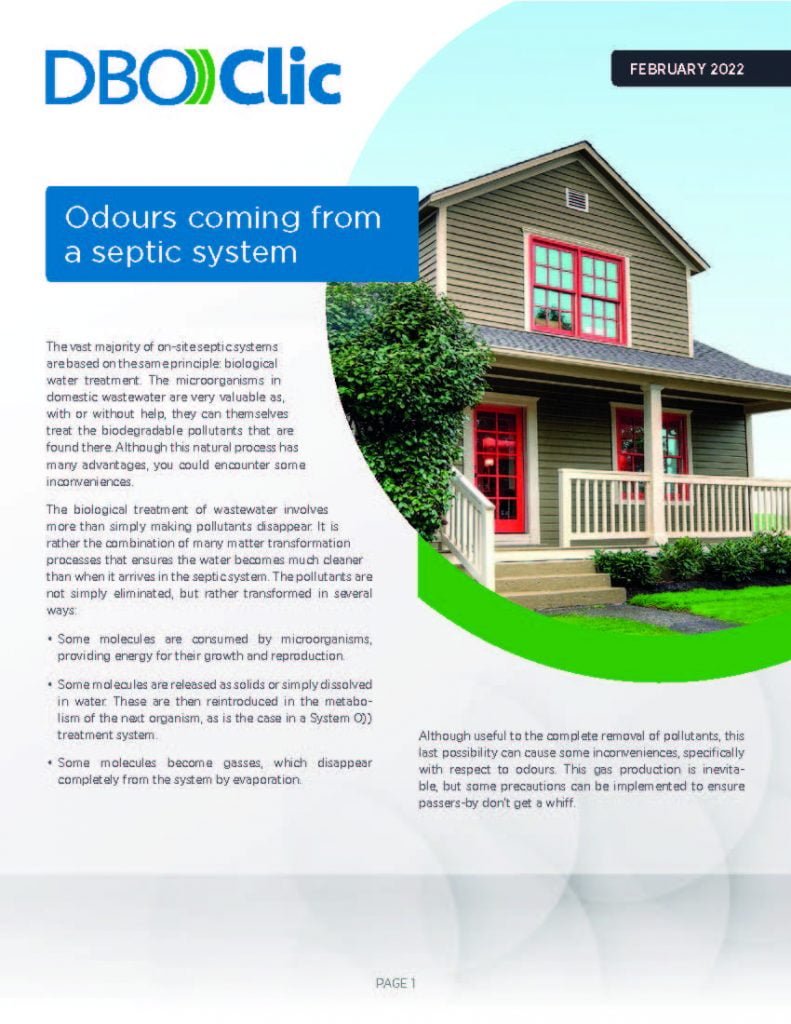The vast majority of on-site septic systems are based on the same principle: biological water treatment. Although this natural process has many advantages, you could encounter some inconveniences – such as odours coming from the septic system.
The biological treatment of wastewater is, in fact, the combination of many matter transformation processes. The pollutants are not simply eliminated, but rather transformed in several ways:
- Some molecules are consumed by microorganisms.
- Some molecules are released as solids or simply dissolved in water, then reintroduced in the metabolism of the next organism, as is the case in a System O)) treatment system.
- Some molecules become gasses.
This gas production is inevitable, but some precautions can be implemented to ensure passers-by don’t get a whiff.

Inside the building
If odours are detected inside, the problem is usually directly related to the plumbing. Although the normal flow to dissipate gasses is through the exit vent on the roof of the building, gasses will try to evacuate through the fastest route. For instance, an empty P-trap (no water) is a common source of odours in a building. Simply filling the P-trap with water blocks the exit.
Other possibilities:
- Using an S-trap, which is more likely to be empty of water
- A P-trap that is too short
- A floor drain that doesn’t have a P-trap or a non-return valve
- For a sink on an island counter – usually not connected to the ventilation – an incoming air valve is required to ensure the P-trap does not empty by suction. This valve can become worn over time.
You might need to contact a plumber to identify where the gasses are coming from.
Outside the building
It is important to understand that to completely dissipate, gasses must achieve a certain exhaust velocity. Many factors can hinder the circulation of gasses, leading to a lower exhaust velocity. This could mean that instead of gasses rising and dissipating in the atmosphere, they will drop to the ground.
Here are some of these factors:
- A badly maintained effluent filter
- A reduction in the diameter of the ventilation circuit
- Many pipe elbows along the way
- An exit vent that does not lead straight up
- Snow or ice that obstructs the roof vent
- Insufficient differential (less than 3 m) between the two vents
Lifting station
When there is a lifting station, the ventilation circuit going from the entry vent to the exit vent is broken by the small-diameter pipes used for pumping and the fact that the pump itself is under water.
The main solution consists in bypassing the lifting station with a ventilation pipe that directly connects the lifting station tank to the septic tank. This means the ventilation remains functional.
If the lifting station is many meters from the treatment system, a simple bypass is impractical. An alternative is to simply create a ventilation circuit specifically for the treatment unit, with its own entry and exit vent. A 3-m differential must be maintained between the two.
Elsewhere on the site
Tank lids that are improperly closed or not airtight are a frequent cause of odours on the site. Start by checking if they are tightly closed; if not, add material (earth, snow) to render the lids impermeable.
An insufficient quantity of earth on top of the treatment system could explain odours on-site.
The dissipation of gasses is strongly influenced by atmospheric pressure. A carbon filter can be installed on the exit vent on the roof. Carbon is very efficient in adsorbing different gasses, so it is often used as a filter. However, the carbon granules must be replaced at a frequency relative to the system’s use – or whenever the odours return.
to conclude
Gas production is inevitable for any wastewater treatment technology based on microorganisms. This gaseous production is in fact an important step towards the complete elimination of some pollutants. A well-conceived and unhindered ventilation circuit is crucial to the efficient dissipation of gasses – which means no issues with odours that are linked to the treatment system.
For a more in-depth look at the issue, please consult the DBO))Clic document below.




